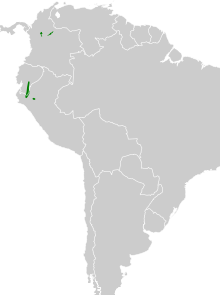The cinnamon screech owl (Megascops petersoni) is a species of owl in the family Strigidae. It is found in the Andes of Ecuador and Peru and possibly Colombia.[3][4]
| Cinnamon screech owl | |
|---|---|

| |
| Scientific classification | |
| Domain: | Eukaryota |
| Kingdom: | Animalia |
| Phylum: | Chordata |
| Class: | Aves |
| Order: | Strigiformes |
| Family: | Strigidae |
| Genus: | Megascops |
| Species: | M. petersoni
|
| Binomial name | |
| Megascops petersoni (Fitzpatrick & O'Neill, 1986)
| |

| |
| Synonyms | |
|
Otus petersoni Fitzpatrick & O'Neill, 1986 | |
Taxonomy and systematics edit
The cinnamon screech owl was first described to science in 1986, one of several Megascops owls described at about that time. Its specific epithet honors Roger Tory Peterson, "the father of modern field guides".[5] Its exact relationships to others of its genus are inexact, but it is thought to be most closely relate to the rufescent screech owl (M. ingens) and cloud-forest screech owl (M. marshalli).[5][6] It is monotypic.[3]
Description edit
The cinnamon screech owl is a small screech owl, 23 to 24 cm (9.1 to 9.4 in) long and weighing 88 to 119 g (3.1 to 4.2 oz). Adults have has a warm brown facial disc with a blackish border and the rest of the face is buffy. They have dark brown eyes, a blue-gray bill, and medium-length "ear" tufts. Their upperparts are cinnamon brown with fine darker brown and buffy vermiculation. The wings and tail are cinnamon as well with brownish and blackish bars. The underparts are a rich cinnamon buff with some warm brown wavy marks on the throat and chest. No juvenile has been described.[5]
Distribution and habitat edit
According to the International Ornithological Committee (IOC) and the Clements taxonomy, the cinnamon screech owl is only known to occur on the eastern slope of the Andes from southern Ecuador into northern Peru.[3][7] However, the South American Classification Committee of the American Ornithological Society (AOS/SACC) also places it in Colombia.[4] It may also occur further south in Peru. It inhabits humid montane forest at elevations between 1,650 and 2,225 m (5,413 and 7,300 ft) in Ecuador and 1,700 and 2,450 m (5,580 and 8,040 ft) in Peru.[5]
Behavior edit
Feeding edit
The cinnamon screech owl is nocturnal, like most others of its genus. Almost nothing is known about its hunting practices or diet, though the latter includes large arthropods and probably small vertebrates.[5]
Breeding edit
The cinnamon screech owl's breeding season, nest, and eggs have not been described. It is assumed to nest in tree cavities like others of its genus.[5]
Vocalization edit
The cinnamon screech owl's primary (territorial) song is "a flat series of hoots" similar to but faster than that of the rufescent screech owl. Its aggressive song is described as "pu-pu-pu-pu-pu pu pu pu pu pu" that starts fast, abruptly slows, and rises in pitch.[5]
Status edit
The IUCN has assessed the cinnamon screech owl as being of Least Concern.[1] However, "As is true of all species that are restricted for humid forest, Cinnamon Screech-Owl is vulnerable to habitat loss, degradation, and forest fragmentation."[5]
References edit
- ^ a b BirdLife International (2016). "Cinnamon Screech-owl Megascops petersoni". IUCN Red List of Threatened Species. 2016. Retrieved 6 August 2021.
- ^ "Appendices | CITES". cites.org. Retrieved 2022-01-14.
- ^ a b c Gill, F.; Donsker, D.; Rasmussen, P. (July 2021). "IOC World Bird List (v 11.2)". Retrieved July 14, 2021.
- ^ a b Remsen, J. V., Jr., J. I. Areta, E. Bonaccorso, S. Claramunt, A. Jaramillo, D. F. Lane, J. F. Pacheco, M. B. Robbins, F. G. Stiles, and K. J. Zimmer. Version 21 June 2021. Species Lists of Birds for South American Countries and Territories. https://www.museum.lsu.edu/~Remsen/SACCCountryLists.htm retrieved June 24, 2021
- ^ a b c d e f g h Schulenberg, T. S. (2020). Cinnamon Screech-Owl (Megascops petersoni), version 1.0. In Birds of the World (T. S. Schulenberg, Editor). Cornell Lab of Ornithology, Ithaca, NY, USA. https://doi.org/10.2173/bow.cinsco1.01 retrieved August 6, 2021
- ^ Remsen, J. V., Jr., J. I. Areta, E. Bonaccorso, S. Claramunt, A. Jaramillo, D. F. Lane, J. F. Pacheco, M. B. Robbins, F. G. Stiles, and K. J. Zimmer. Version 23 May 2021. A classification of the bird species of South America. American Ornithological Society. https://www.museum.lsu.edu/~Remsen/SACCBaseline.htm retrieved May 24, 2021
- ^ Clements, J. F., T. S. Schulenberg, M. J. Iliff, S. M. Billerman, T. A. Fredericks, B. L. Sullivan, and C. L. Wood. 2019. The eBird/Clements Checklist of Birds of the World: v2019. Downloaded from https://www.birds.cornell.edu/clementschecklist/download/ Retrieved August 15, 2019
Further reading edit
- Mikkola, Heimo (2012). Owls of the World: A photographic guide. Buffalo, NY, US: Firefly Books. p. 226.
